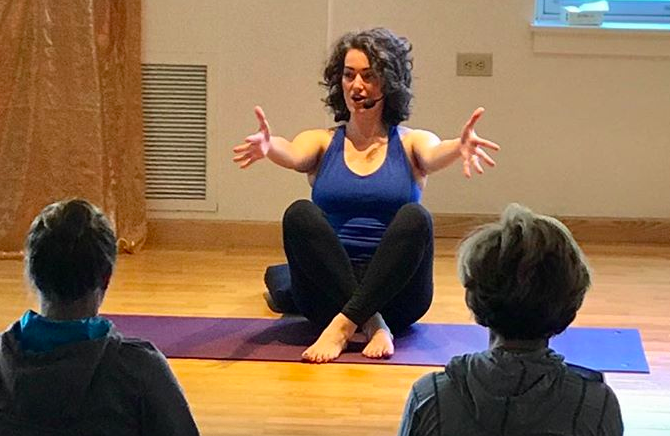Excerpt from The Professional Yoga Teacher’s Handbook: The Ultimate Guide for Current and Aspiring Instructors—Set Your Intention, Develop Your Voice, and Build Your Career © Sage Rountree, 2020. Reprinted by permission of the publisher, The Experiment. Available wherever books are sold.
~
Yoga has helped you, and now you want to share what you’ve learned.
You’ve seen your teachers over the years as wise guides and role models, and while you’re naturally nervous that you won’t be able to fill their shoes, you’re starting to feel the urge to try. Great!
Or maybe you’ve been teaching for a while, but you feel unsure about how to get a studio job, develop a workshop, establish clear boundaries with your students, create online content, or level up in your career. You may simply want to get back to the basics of good teaching. Also great!
Wherever you are in your career, it’s useful to step back to see the big picture, check in with your own abilities and goals, and choose a wise path toward where you want to be. These days, there are images of yoga practitioners and teachers coming at you from all angles, and it can be confusing to sift through the chatter to get at the heart of what yoga means to you and then at the question of how you might be able to help others through yoga.
Let’s start by cutting through the noise.
Look Back on Your Path
Spend some time considering your answers to these questions, then open your journal or a notes file and write about them. You’ll find all these workbook prompts here.
>> What led you to yoga?
>> What do you love about yoga? What does yoga have to teach you? What do you have to teach others about yoga?
>> What do you find confusing, or off-putting, or difficult about yoga? How can you make peace with these parts of the practice?
>> Why did you pick up this book? What do you want to learn?
Anyone is a Potential Teacher
Our teacher trainees at the studio I co-own, Carolina Yoga Company, have included an ex-professional poker player, a current professional salsa dancer, bartenders, grad students, home-schooled sixteen-year-olds, doctors, nurses, lawyers, schoolteachers, stay-at-home moms, and retirees. Anyone can be a yoga teacher. And although being a good yoga teacher takes practice, there is nothing that inherently disqualifies you from trying.
The things that make you different from the idealized yoga teacher in your mind’s eye (based on what you see in advertising and on your Instagram feed) are the very things that will make you unique and appealing to your students.
Recognize what you are bringing to the table. If you have a background in gymnastics and facility with the showier poses, great! This may be your niche. If you have a history as a couch potato, or are rehabbing an injury, great! This can lead to a different niche. Your life experiences will make you sympathetic to the students you can help best. You’re best at being exactly who you are. And your authenticity in your personality and your experiences will be the strongest part of your teaching.
Don’t let body image stop you from stepping into the seat of the teacher. You do not have to be Instagram-fitfluencer thin and young. There’s no shortage of slim, white, economically privileged yoga teachers in the world—and if this is you, you are certainly welcome, too. But what the world really needs is more authentically real people as teachers. The pain points you’ve discovered in your yoga practice are the very topics on which you’ll be the strongest teacher.
And on the other hand, the things that come easiest to you in your practice, whether they be advanced asanas, or relaxing immediately in restorative poses, or sustaining meditation with little effort, will be your biggest blind spots as a teacher. The struggle you have gone through to master whatever is most difficult for you will better equip you to be a helpful teacher. You’ll have the experience, the language, and the skills to help others who arrive on their mats looking for guidance just as you once did.
Check Your Blind Spots
Journal on your answers to these questions.
>> What comes easy to you in asana? Are there categories of poses or styles of yoga that you excel at? Why? Is it something in your body, or your mind, or your background? What comes easy to you in breathing, meditation, and the other yoga techniques beyond asana?
>> What do you find challenging? Why is that? Can you drill down on the nature of the challenge?
>> How could these point you toward approaches you should study more? How can recognizing your blind spots help you shore them up?
You Aren’t Bryan
I was fortunate to receive some really helpful feedback—some of the most useful teaching advice I’ve ever heard—after my second public class. I hadn’t meant to be teaching that night, and in fact I’d given my first-ever class the evening before. But when the front desk staff told me that the regular teacher, Bryan, wouldn’t make it, I eagerly threw my hand in the air and said, “I’ll teach the class!” In class, I repeated the sequence I’d prepped for the previous evening, complete with numerous apologies for not teaching the same poses in the same way as Bryan, and while I was nervous, I thought it went pretty well.
The next day, I saw two of the students who’d been in the room. Approaching me, they explained that they were schoolteachers and as such were used to giving and receiving peer critiques. Was I open to hearing some advice? Of course, I said.
“We could tell you weren’t Bryan, so you didn’t need to apologize for not being Bryan,” they offered.
What an important thing to be told so early on! Not only did I make the mistake of drawing attention to my self-perceived flaws, I was unnecessarily comparing myself to the regular teacher, which hobbled my own attempt at teaching authentically. It was obvious to the room that I was a different teacher; I didn’t need to compare myself or point out all the ways I wasn’t him. Instead, I was free to be Sage, authentically and without apology. The students were grateful to have a teacher that evening, rather than no teacher at all.
Remind yourself: You don’t have to be Bryan. You don’t have to be Sage—only I do. You only have to be yourself.
This experience also taught me to be receptive to student feedback. Don’t expect to follow it all, but listen to what your students tell you, as they will be some of your greatest teachers.
The Perfect Side Hustle
Let me be perfectly clear right up front: Teaching yoga is not an ideal primary profession, despite what social media might imply. The market is ever more saturated with teachers; studios are paying less and per hour; venues for teaching workshops are on the decline; the big-name yoga festivals don’t pay much to presenters. There are only so many hours in a week that you can be physically present to teach. And then, along comes a pandemic to shut down in-person classes!
But while it’s not usually the best choice for a full-time job, teaching yoga is a lovely second job. Teaching yoga is my second or third job, after business ownership and writing. At Carolina Yoga Company, we have only a handful of teachers on our large staff across three studios whose sole job is teaching yoga. Far more common is to work a part-time or full-time job in another field, with yoga as a side hustle. Our teachers have all sorts of jobs: working at IBM, running an accounting firm, working for the federal government, and teaching from preschool to college, among others. Those who teach full time are often cushioned by having a partner with a well-paying job. That’s certainly the case for me. I recognize this immense privilege, and I strive to use it in the service of helping others.
All the good reasons someone might want to become a yoga teacher have service at their core. The bad reasons have ego: wanting power over others, more rigid control over your own body, or oodles of money. But as the yoga sutras tell us, attachment to ego (asmita) causes suffering. Remember that service is at the core of your work. But that doesn’t mean that you need to do it for free! The more you are paid for your teaching, the more you’ll be able to give your teaching away to those who wouldn’t otherwise receive it.
Teaching Your First Class
If you take part in teacher training, your first class will usually happen in that context. Trainees may be encouraged to create their own small classes for family and friends, or to take yoga into the community.
The obvious next step after teacher training is to start teaching somewhere you are needed. This can be a community group, a gym, a yoga-in-the-park offering, in a special-interest group online—anywhere that lets you continue to practice and grow. This could be paid work or volunteer work. It’s also a wonderful ongoing practice, especially if you’ve been teaching for a while and feel like your teaching is getting stale. Taking your work out of the studio setting and into the community helps bring yoga’s gifts to those who need it most, while also reigniting your passion for the practice.
You might also consider a work-study program to get your foot in the door. At Carolina Yoga Company, several of our graduates are on our teaching roster. Most of them came through our work-study program, which gets new staff up to speed on our procedures and keeps potential new teachers top of mind when we write our quarterly teaching schedule. Many studios have such a program; if not, consider suggesting one or working the front desk. Being a work-study student is like joining the farm team; moving to the sub list is like getting to AAA baseball. You might get called up in a pinch, so performing well and being easy to work with can earn you a spot on the major-league roster. All along the way, you’re getting an inside view of the organization, its systems, and its values.
~
Excerpt from The Professional Yoga Teacher’s Handbook: The Ultimate Guide for Current and Aspiring Instructors—Set Your Intention, Develop Your Voice, and Build Your Career © Sage Rountree, 2020. Reprinted by permission of the publisher, The Experiment. Available wherever books are sold.











Read 2 comments and reply